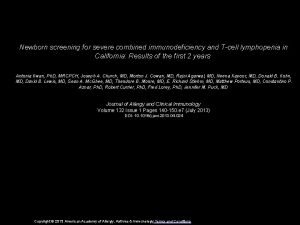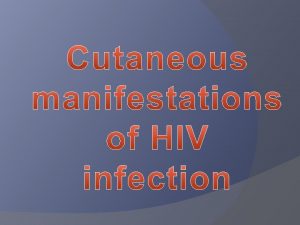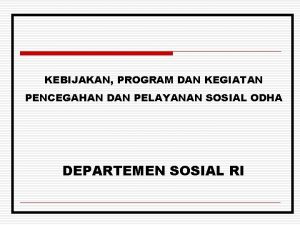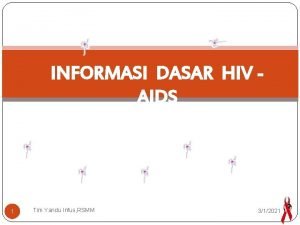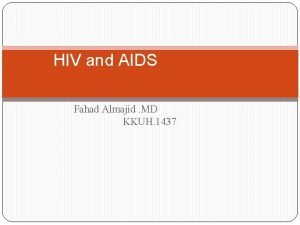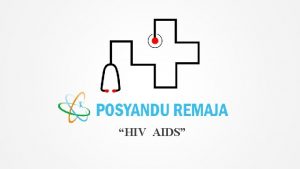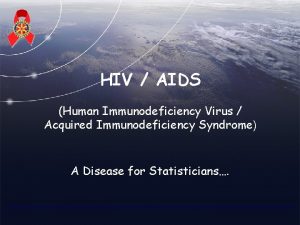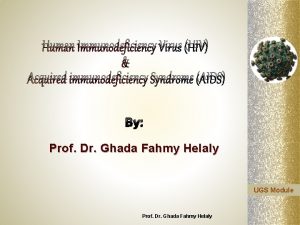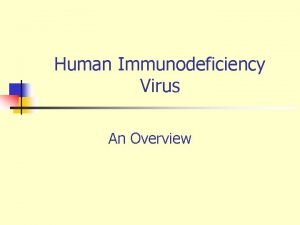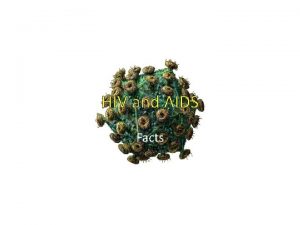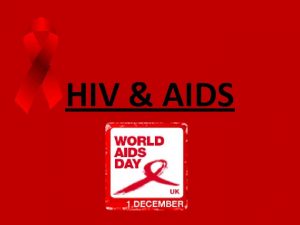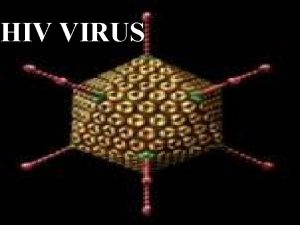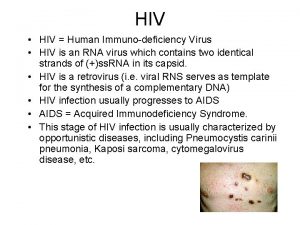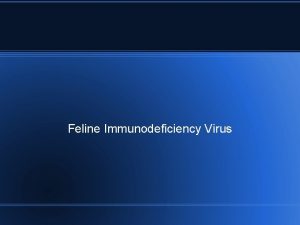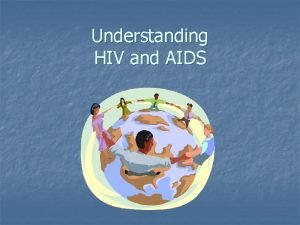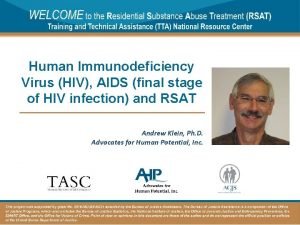HIV and AIDS Human Immunodeficiency Virus HIV causes














- Slides: 14

HIV and AIDS Human Immunodeficiency Virus (HIV) causes Acquired Immune Deficiency Syndrome (AIDS)

HIV is a retrovirus • 2 kinds of virus: RNA or DNA, depending on what kind of genetic material the carry and use to replicate themselves inside a host. • RNA viruses: SARS, influenza, hepatitis C, HIV • DNA viruses: herpes, HPV, chicken pox, smallpox • Retroviruses carry RNA that is then transcribed back into DNA and the DNA is integrated into the host cell using reverse transcriptase • This is how retroviruses work.

How does HIV invade and take over cells? • HIV attacks immune cells, which weakens the immune system • Glycoproteins on the outside of the virus bind with helper T (TH) lymphocytes (sometimes called WBC or white blood cells) • Viral proteins and RNA are released into the host cell • Reverse transcriptase transcribes the RNA into DNA • The new viral DNA is incorporated into the host’s genome (called a provirus) – So…. what kind of replication method does HIV use? Lytic or lysogenic? • The new genome provides all instructions needed to make complete new viruses • Offspring viruses bud off from host cell and invade other cells

HIV is a retrovirus odd in that buds from the cell and doesn’t destroy it during lytic phase…. .

Good HIV simulation…. • http: //www. sumanasinc. com/webcontent/ani mations/content/lifecyclehiv. html

HIV and your immune system • HIV invades TH lymphocytes, cells which normally assist in the destruction of viruses • HIV mutates at a high rate during replication • Altered proteins on the surface of the virus can make it unrecognizable and allow it to evade destruction and mutate further • The viral DNA “hides” in the host DNA where antiviral drugs cannot destroy it • The invasion of TH cells weakens the immune system making the victim susceptible to infections and cancers

Transmission • • Blood to blood contact Unprotected sex Needle sharing, untested blood transfusions Pregnant or nursing mother to infant

Statistics • 0. 6% of the Worlds population is infected • Since 1981, the virus has killed over 25 million people (one third from sub-Saharan Africa) • 10. 8% of South Africans are HIV positive • On average about 22% of infected people get treatment worldwide • The U. S. spends about $6 billion/year on prevention (not treatment)

In 2010, 40 million people worldwide living with HIV/AIDS


In the U. S. : CDC HIV Surveillance Data for 2009

US Snapshot for 2012 from Kaiser Family Foundation

CDC Surveillance Data: 48, 000 new HIV diagnoses/year

Treatments • HAART (highly active antiretroviral therapy) – Inhibit reverse transcriptase – Inhibit protease (the proteins found on the outside of the virus) – Intregrase inhibitors (inhibit the binding of HIV to TH cells)
 What are deficiency
What are deficiency Combined immunodeficiency
Combined immunodeficiency Chapter 25 sexually transmitted infections and hiv/aids
Chapter 25 sexually transmitted infections and hiv/aids Chapter 24 sexually transmitted diseases and hiv/aids
Chapter 24 sexually transmitted diseases and hiv/aids Test wiedzy o hiv
Test wiedzy o hiv Causative organism of hiv/aids
Causative organism of hiv/aids Oral pathology
Oral pathology Kasus hiv aids
Kasus hiv aids Stadium hiv menurut who
Stadium hiv menurut who Hiv virus
Hiv virus Retropharyngeal anatomy
Retropharyngeal anatomy Croup contagious
Croup contagious Proximate causes of behavior
Proximate causes of behavior Animal behavior biology
Animal behavior biology Beowulf reading check answers
Beowulf reading check answers

